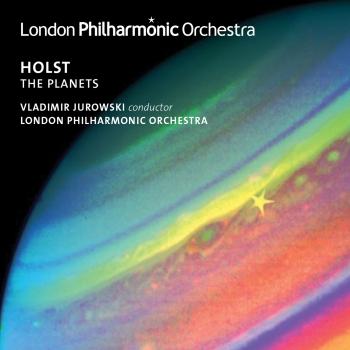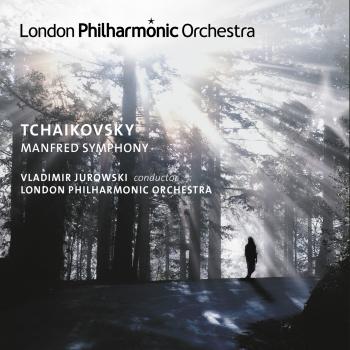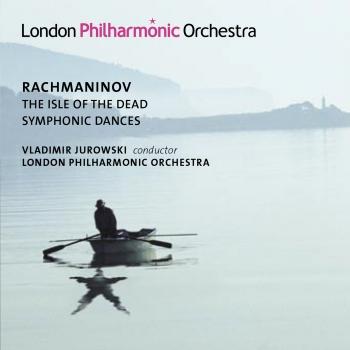
Mahler Symphony No. 1 London Philharmonic Orchestra & Vladimir Jurowski
Album Info
Album Veröffentlichung:
2013
HRA-Veröffentlichung:
19.11.2013
Label: London Philharmonic Orchestra
Genre: Classical
Subgenre: Orchestral
Interpret: London Philharmonic Orchestra & Vladimir Jurowski
Das Album enthält Albumcover Booklet (PDF)
- Gustav Mahler (1860–1911): Symphony No. 1 in D major
- 1I. Langsam, schleppend15:56
- 2II. Blumine06:48
- 3III. Kraftig bewegt, doch nicht zu schnell08:16
- 4IV. Feierlich und gemessen, ohne zu schleppen10:17
- 5V. Sturmisch bewegt19:34
Info zu Mahler Symphony No. 1
Mahler’s First Symphony: the opening chapter of his spiritual autobiography. And the music itself seems to awaken – emerging from hushed strings and woodwind cuckoos into its stride, marching forth, stamping towards an eerie realisation of a nursery rhyme and arriving at a final, blazing affirmation of confidence.
Vladimir Jurowski conducts the London Philharmonic Orchestra in this live 2010 concert performance including the Symphony’s original second movement, ‘Blumine’.
“an undeniably fresh and often startling performance...Jurowski 'hears' everything but better yet the reasons for everything. His precipitous way with tempo contrasts creates moments of high drama in the outer movements...if ever there was a case for wanting the roar of applause, this is it.” (Gramophone)
“This is an extraordinarily sensitive and nuanced account which eschews the temptation to stick to the sunny-side and run blithely through the score. There are frequent, telling adjustments in the phrasing which never sound fussy or applied...I look forward to more of Jurowski's Mahler with the LPO; this recording is a triumph.” (MusicWeb International)
London Philharmonic Orchestra
Vladimir Jurowski, conductor
Recorded live at Southbank Centre’s Royal Festival Hall, London on 4 December 2010.
From the preface of Gustav Mahler: Symphony No. 1
Little is known about the genesis of Mahler’s Symphony No. 1. A connection to two women – the singer Johanna Richter and Marion von Weber – is documented, which may have been the reason that Mahler took efforts not to let very much be known about it. Originally, ‘Blumine’ was planned as the second movement of the symphony. It was composed in 1884 as a part of a set of ‘living pictures’ based on Scheffel’s Trompeter von Säkkingen which Mahler otherwise destroyed. His Lieder eines fahrenden Gesellen are thematically related to the symphony and were also composed in that same year. There is a large break between these preliminary studies and the final version of the symphony which Mahler wrote in just six weeks in the spring of 1888; he said that it ‘virtually gushed like a mountain stream’ (letter to Friedrich Löhr in March 1888). There must have been further preparatory work in this period, but almost nothing datable has survived.
Mahler conducted the premiere performance of the Symphony No. 1 in Budapest on 20 November 1889. Here it was appropriately called a ‘Symphonic Poem’, since the similarities to the programmatic ‘Neudeutsche Symphonic Poems’ are undeniable. Although Mahler revised the score thoroughly in the first part of 1893, he still felt it necessary to print the following indication of the work’s contents for a performance in Hamburg on 27 October 1893:
7. ‘The Titan’, A Tone Poem in the form of a symphony (manuscript) .....
Mahler
1st Part ‘Childhood Memories’, flowers, fruits and thorns
I. ‘Eternal Spring’ (Introduction and Allegro comodo)
The introduction represents the re-awakening of Nature after a long winter.
II. ‘Biumine’ (Andante)
III. ‘The wind in my sails’ (Scherzo)
2nd Part ‘Commedia humana’
IV. ‘Shipwrecked’ (a funeral march in the style of Jacques Callot)
The following should help understand this movement. The inspiration for this piece can be seen in the satirical picture ‘The Hunter’s Funeral’ which is known to all Austrian children: The animals of the forest accompany the coffin of the deceased hunter to his grave; rabbits carry little banners preceded by a band of Bohemian musicians; there are music-making cats, toads, crows, etc. and elk, deer, foxes and other four-legged and feathered beasts of the forest participate in the procession assuming dance-like poses. At this point, the piece wavers between ironic and humorous moods here and mysterious, brooding ones there. This is immediately followed by
V. ‘Dall’ Inferno’ (Allegro furioso)
which represents the sudden explosion of despair coming from a deeply wounded heart.
As a matter of fact, a large variety of art forms (pictures, literature, music) and levels of appreciation (including folk art and popular subjects) can be seen as sources for Mahler’s inspiration. As in other works, Mahler did not refer to these programmatic elements later, with the exception of the title of the symphony, which he even weakened: ‘the so-called Titan’. He prepared a second revision for a performance on 16 March 1896 in Berlin which deleted the Blumine movement – the title became simply ‘Symphony in D major’.
The work was first printed in 1898/1899 by Josef Eberle & Co in Vienna, at a time when Mahler was already director of the Court Opera House. The first edition was sold by Weinberger and was incorporated into Universal Edition in 1909. The composer, however, reserved the right to carry out further revisions. He made changes in the instrumentation for virtually every performance to better express his growing demands and to make it ‘beautifully transparent and perfect’. Right up to the last performance of the work which he conducted in New York in December 1909, Mahler revised the orchestral parts – before and after the concert.
The present score reproduces the Improved Edition that was published in 1992 by Sander Wilkens in the series of the Critical Complete Edition. This in turn was based on Erwin Ratz’s ‘Fassung letzter Hand’ (Final Version), in which the attempt was made for the first time to collate all of the authentic changes including the aforementioned New York revision of 1909/1910. Wilken’s interpretation of the ‘Solo’ indication in the double basses at the opening of the third movement as a ‘group solo’, i.e. only double basses without violoncellos, and not as a performance by a single player, has met in some places with criticism – the final word about it has definitely not been heard. It should be noted that Mahler specifically requested stronger forces for the final chorale (fourth movement, starting at bar 656): at least by ‘an extra trumpet and an extra trombone’ but ‘naturally more horns [would be] preferable’ (letter to Franz Schalk concerning a performance in Prague in 1898), i.e. at least nine horns.


 Vladimir Jurowski
Vladimir Jurowski
One of today’s most sought-after conductors, acclaimed worldwide for his incisive musicianship and adventurous artistic commitment, Vladimir Jurowski was born in Moscow in 1972, and completed the first part of his musical studies at the Music College of the Moscow Conservatory. In 1990 he relocated with his family to Germany, continuing his studies at the Musikhochschule of Dresden and Berlin, studying conducting with Rolf Reuter and vocal coaching with Semion Skigin. In 1995 he made his international debut at the Wexford Festival conducting Rimsky-Korsakov’s May Night, and the same year saw his debut at the Royal Opera House Covent Garden with Nabucco.
Vladimir Jurowski was appointed Principal Guest Conductor of the London Philharmonic Orchestra in 2003, becoming the orchestra's Principal Conductor in September 2007. He also holds the titles of Principal Artist of the Orchestra of the Age of Enlightenment and Artistic Director of the Russian State Academic Symphony Orchestra. He has also held the positions of First Kapellmeister of the Komische Oper Berlin (1997-2001), Principal Guest Conductor of the Teatro Comunale di Bologna (2000-2003), Principal Guest Conductor of the Russian National Orchestra (2005-2009) and Music Director of Glyndebourne Festival Opera (2001-2013).
Vladimir Jurowski has appeared on the podium with many of the world's leading orchestras in both Europe and North America, including the Berlin and Vienna Philharmonic Orchestras, the Royal Concertgebouw Orchestra, Philadelphia Orchestra, New York Philharmonic, Cleveland Orchestra, Boston Symphony, Chicago Symphony, Tonhalle Orchester Zurich, Gewandhausorchester Leipzig, and the Staatskapelle Dresden.
Highlights of the 2014/15 season and beyond include his return visits to the New York Philharmonic, Boston Symphony, Royal Concertgebouw and Philadelphia Orchestras; tours with the Chamber Orchestra of Europe and the Orchestra of the Age of Enlightenment, and an unique project with the London Sinfonietta in Moscow to celebrate the Anglo-Russian Year of Cultural Exchange.
Jurowski made his debut at the Metropolitan Opera New York in 1999 with Rigoletto, and has since returned for Jenufa, The Queen of Spades and Hansel und Gretel. He has conducted Parsifal and Wozzeck at the Welsh National Opera, War and Peace at the Opera National de Paris, Eugene Onegin at Teatro alla Scala Milan, Ruslan and Ludmila at the Bolshoi Theatre, and Iolanta and Der Teufel von Loudon at the Dresden Semperoper, as well as Die Zauberflöte, La Cenerentola, Otello, Macbeth, Falstaff, Tristan und Isolde, Die Meistersinger von Nurnberg, Don Giovanni, The Rake’s Progress, The Cunning Little Vixen, Ariadne auf Naxos and Peter Eötvös’ Love and Other Demons at Glyndebourne Opera. In 2013 he returns to the Metropolitan Opera for Die Frau ohne Schatten, and future engagements include Moses und Aron at the Komische Oper Berlin and The Fiery Angel at the Bayerische Staatsoper in Munich.
Jurowski’s discography includes the first ever recording of the cantata Exile by Giya Kancheli for ECM, Meyerbeer’s L’etoile du Nord for Marco Polo, Massenet’s Werther for BMG, and a series of records for PentaTone with the Russian National Orchestra, including Tchaikovsky's Orchestral Suite No. 3 and Stravinsky's Divertimento from Le baiser de la fée, Shostakovich Symphonies No 1 & 6, Prokofiev Symphony No 5, and Tchaikovsky’s Hamlet Incidental Music. The London Philharmonic Orchestra has released a wide selection of his live recordings on their LPO Live label, including the complete symphonies of Brahms, Mahler Symphony No. 2, Rachmaninov’s Symphonic Dances, Tchaikovsky’s Symphonies 1, 4, 5, 6 and Manfred, and works by Turnage, Holst, Britten, Shostakovich, Honegger and Haydn. Most recent releases have included Zemlinsky’s A Florentine Tragedy, and an album of orchestral works by the Orchestra's Composer in Residence, Julian Anderson. His tenure as Music Director at Glyndebourne has been documented in CD releases of La Cenerentola, Tristan und Isolde and Prokofiev’s Betrothal in a Monastery, and DVD releases of his performances of Ariadne auf Naxos, La Cenerentola, Gianni Schicchi, Die Fledermaus, Die Meistersinger von Nurnberg, Don Giovanni, and Rachmaninov’s The Miserly Knight, and other DVD releases include Hansel und Gretel from the Metropolitan Opera New York, his first concert as London Philharmonic Orchestra’s principal conductor featuring works by Wagner, Berg and Mahler, and DVDs with the Orchestra of the Age of Enlightenment (Beethoven symphonies 4 and 7) and the Chamber Orchestra of Europe (Strauss and Ravel), all released by Medici Arts.
Petra Lang
After completing violin studies she studied singing with Gertie Charlent at the Akademie für Tonkunst in Darmstadt and at the Peter Cornelius Conservatory in Mainz, where she attended the Opera School with Harro Dicks at the same time. After completing her studies in 1989 she immediately auditioned for a master class with Ingrid Bjoner with whom she studied until 2006. She was involved in masterclasses with Brigitte Fassbaender, Hans Hotter, Dietrich Fischer-Dieskau, Peter Schreier and also studied her Wagner roles with Astrid Varnay. She works now with Angelo Loforese.
In 1989, Petra Lang joined the Opera Studio of the Bavarian State Opera in Munich. In 1990, she moved to the Theater Basel, sang in 1991 at the Städtischen Bühnen Nuremberg and 1992-1995 at Theater Dortmund. Here she could develop numerous roles of the lyric mezzo-soprano repertoire. In addition, she was engaged as Tamiri in Mozart's "Il Re Pastore" at De Nederlandse Opera Amsterdam, as Virtu in Monteverdi's "L'Incoronazione di Poppea" at the Salzburg Festival, as Fenena in Verdi's "Nabucco" at the Bregenz Festival and as Flora in "La Traviata" at the Zurich Festival.
In 1994/95 season, she turned to the work of Richard Wagner, and sang her first Waltraute (“Götterdammerung”) and Fricka (“Das Rheingold”, “Die Walküre”) in the Dortmund Ring cycle. Under the opera direction of Brigitte Fassbaender at the Staatstheater Braunschweig from 1995-1997 she added to her repertoire Brangäne (“Tristan und Isolde”), Judith (“Duke Bluebeard's Castle”), Marie (“Wozzeck”) and Eboli (“Don Carlos”).
Then Petra Lang decided to become freelance and since then sings on the world’s greatest stages: Royal Opera House London (Brangäne, Waltraute, Kundry, Ortrud, Ariadne, Judith, Foreign Princess), De Nederlandse Opera Amsterdam (Brangäne, Cassandre, Venus, Kundry), Bavarian State Opera Munich (Brangäne, Venus, Sieglinde, Kundry), Deutsche Oper Berlin (Waltraute, Brangäne, Venus, Sieglinde, Cassandre, Ortrud), Hamburg State Opera (Waltraute, Kundry), Staatstheater Stuttgart (Adriano), Opera Cologne (Sieglinde), Nationaltheater Mannheim (Cassandre, Ariadne, Kundry), Vienna State Opera (Fricka, Waltraute, Brangäne, Kundry, Ortrud), De Vlaamse Opera Antwerp (Brangäne), Grand Théâtre de Genève (Amneris, Kundry, Judith, Ortrud), Zurich Opera House (Sieglinde), Teatro San Carlo, Naples (Sieglinde), Accademia di Santa Cecilia Rome (Venus), Teatro La Fenice Venice (Sieglinde), La Scala Milan (Venus), Oviedo (Brangäne), Teatro de la Maestranza Seville (Sieglinde), Budapest (Ortrud), Opera Nationala Bucharest (Ortrud), Tokyo (Kundry), Teatro Municipal di Santiago de Chile (Brangäne), San Diego Opera (Venus), Baltimore Opera (Venus), Lyric Opera of Chicago (Brangäne), San Francisco Opera (Venus, Ortrud).
She sang her first Brünnhilde in concerts in 2012/13: "Die Walküre" and "Götterdämmerung" in Berlin and Bucurest with RSO-Berlin under Marek Janowski and in Bamberg and Luzern with the Bamberger Symphoniker under Jonathan Nott, "Siegfried" with Stuttgarter Philharmoniker under Gabriel Feltz. At the Opéra National de Paris she sang Brünnhilde in Günter Krämers production of "Götterdämmerung" under Philippe Jordan. She appeared in Dieter Dorns Ring-Cycle in Geneva and sang Brünnhilde in Siegfried under Adam Fischer in Budapest.
At the Bayreuth Festival Petra Lang has sung Brangäne in "Tristan und Isolde" (2005/2006), and as Ortrud in “Lohengrin” by Hans Neuenfels in 2011. In addition to her successes on the opera stage, she is an internationally sought-after concert singer who is known mainly for her sensitive interpretation of the works of Gustav Mahler. On the concert podium Petra Lang also sings Wagner's Wesendonck Lieder, Berlioz’s Les nuits d 'été, Berg's Seven Early songs and the Wozzeck Fragments, Schoenberg's Songs Op.8 and the Wood Dove in Gurrelieder, Zemlinsky’s Maeterlinck songs, Sibelius, Duparc, Lalo, Strauss orchestral songs, in Beethoven's 9th Symphony and the Missa Solemnis.She performs worldwide with all the major orchestras under the direction, amongst others, of Claudio Abbado, Pierre Boulez, Christian Badea, Semyon Bychkov, Riccardo Chailly, M. W. Chung, Andrew Davis, Colin Davis, Christoph von Dohnányi, Charles Dutoit, Christoph Eschenbach, Adam Fischer, Ivan Fischer, Bernard Haitink, Marek Janowski, Armin Jordan, Philippe Jordan, Zubin Mehta, Ingo Metzmacher, Riccardo Muti, Andris Nelsons, Yannick Nézet-Séguin, Jukka-Pekka Saraste, Wolfgang Sawallisch, Leif Segerstam, Simon Rattle, Donald Runnicles, Peter Schneider, Jeffrey Tate, Christian Thielemann, Silvio Varviso, Simone Young.
Also Petra Lang has a successful career as a Lieder singer. She sings a comprehensive repertoire of Lieder from Franz Schubert to Anton Webern, and works with the pianists Adrian Baianu, Malcolm Martineau, Carmen Piazzini, Maurizio Pollini, Wolfram Rieger, Charles Spencer, and Einar Steen-Noekleberg. Their song recitals have been performed at, amongst others, Wigmore Hall (London), Concertgebouw (Amsterdam), Schubertiade (Feldkirch), Semper Opera House (Dresden), La Scala (Milan), Carnegie-Weill Hall (New York), Salle Pleyel (Paris) and at the Edinburgh Festival.
Petra Lang is in addition a singing advisor. During and after her violin studies she worked from 1983 to 1989 as teacher of violin, viola, early musical education and musical training at the Gross-Gerau Music School, and at the Municipal Music School in Rüsselsheim, Germany. With this in-depth educational experience, it is Petra Lang’s concern to give young colleagues professional suggestions and advice for singing in larger rooms. This way of singing she drew up with the pianist and vocal coach Adrian Baianu, it is based on old Italian vocal techniques and has been transferred to the German vocal repertoire.
She gave master classes for the Mahler Society of London (2006), at the Cologne Musikhochschule (2007), in Münster (2007), and together with Adrian Baianu in Münster (2008) , London (2009, 2012) and at the Bayreuth Festival 2013.
London Philharmonic Orchestra
Recognised today as one of the finest orchestras on the international stage, the London Philharmonic Orchestra was founded in 1932 by Sir Thomas Beecham. Since then, its principal conductors have included Sir Adrian Boult, Bernard Haitink, Sir Georg Solti, Klaus Tennstedt and Kurt Masur. In 2007 Vladimir Jurowski became the orchestra’s principal conductor and in 2008 Yannick Nézet-Séguin was appointed principal guest conductor.
The London Philharmonic Orchestra has been performing at Southbank Centre’s Royal Festival Hall since it opened in 1951 becoming resident orchestra in 1992. It also has flourishing residencies in Brighton and Eastbourne and performs regularly around the UK. Each summer it plays for Glyndebourne Festival Opera where it has been resident symphony orchestra for 50 years. The orchestra also regularly tours abroad: highlights of the 2013–14 season include visits to the USA, Romania, Austria, Germany, Slovenia, Belgium, France and Spain.
In summer 2012 the London Philharmonic Orchestra performed as part of The Queen’s Diamond Jubilee Pageant on the River Thames and was also chosen to record all the world’s national anthems for the London 2012 Olympics. The orchestra broadcasts regularly on television and radio and has recorded soundtracks for numerous blockbuster films including The Lord of the Rings trilogy. It has made many distinguished recordings over the last eight decades and in 2005 began releasing live, studio and archive recordings on its own CD label.

















